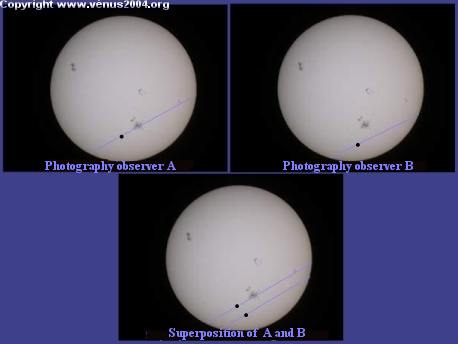|
|
Venus2004.org
> Files
ALL THE METHODOLOGIES NEED TWO DISTANT OBSERVERS IN NORTH-SOUTH DIRECTION
2°)Photographic methodology or parallax methodology This methodology needs at least 2 distant observers, located imperatively at different latitudes, in opposite hemispheres. The distance North-South must be as big as possible and the difference of longitudes should not be too big (exemple: Norway-South Africa, Finland-Madagascar…) Each observer has to be equipped with a telescope and a photographic camera.. The photographs taken by both observers must be done at the same moment (every 10 minutes, for example). These observers will see the transition of Venus in front of the sun on two different trajectories. This is called « the parallax effect » The difference of trajectory is linked to the parallax effect and is in direct relation with the astronomical unit. Note: Depending the kind of mount used with the telescope, the trajectory of Venus will be different. If the mount is"equatorial", the trajectory followed by Venus will be straight. If the mount is "Alt-azimutal", the trajectory followed by Venus will be curved. Methodology summary The photographs must be taken at the same time intervals and done very accurately for both observers A and B located at different locations. The trajectories of Venus will be different for each observer (parallax effect) The photography taken by the observer A at one moment will be superposed with the photography taken at the same moment by the observer B. This process will give the final photography C.  Photograph superposition, credits: Venus2004.org Several important points have to be respected for the observation configuration A) You have to decide on the interval for the photographs ( hour/minutes/seconds). The best choice would be every 15 minutes ( 6Hours 00Min 00Sec, 6Hour 15Min 00Sec…) B) The telescope should be aligned with Polaris during the night before the transit. It is then recommended to be at the observation site a while before the transit. This will also allow your telescope to stabilize its temperature to the ambient temperature. Doing this the telescope will be stable and the air turbulence inside the telescope will be minimized. If the telescope is not aligned with Polaris you will have to correct often the position of the telescope to keep Venus in the the field of vision. C) The position of the photographic camera : It has to be located at the focal point of the telescope. A digital camera can also be used with an eyepiece. In some case a webcam can also be used*. Different cases possible : 1) No sunspots visible on the sun The position of the camera must not be modified during the entire transit phase if the sun has no visible sunspot. In this case both observers must set their cameras with the same orientation ( North located at the top position ) 2)Two sunspots or more: If the solar disk contains at least two distant sunspots, the position of the camera can be modified. Both sunspots, Venus and the edge of the sun must be visible on the picture.These sunspots will be used to superpose both pictures. In both cases , half of the solar disk must at least be seen on the picture. 3)If Venus progresses close to a sunspot: This case is not very likely. If Venus progresses near a sunspot, it would be very beneficial to use a webcam to make a picture using a great magnification. This process would allow making a very precise superposition. Venus and the sunspot must be on the picture. In this situation the use of a barlow lens with the webcam can be very interesting. The use of a digital camera with an eyepiece which will give a powerful magnification can also be very interesting. If you do not have such an eyepiece, cosider using a barlow lens to get a great magnification. * A webcam can be used for points 1 and 2 if it is equipped with a focal reducer. D) Coordinates and moments : Be sure to write down the moments at which the pictures were taken. The geographic coordinates of both observers must be identified carefully; do not forget to mention this in your report. In summary After the observation, both observers will have : -a set of pictures taken under the same conditions and at the same UT moments -their geographic coordinates CAUTION : Observing the sun can be very dangerous,therefore the safety precautions MUST be respected, see: http://www.venus2004.org/sinformer/n/news3366.php?langue=1 |
|
© 2003-2006 Futura-Sciences.com. All rights reserved.
Indexator - Comparateur de prix - Revue de Presse
